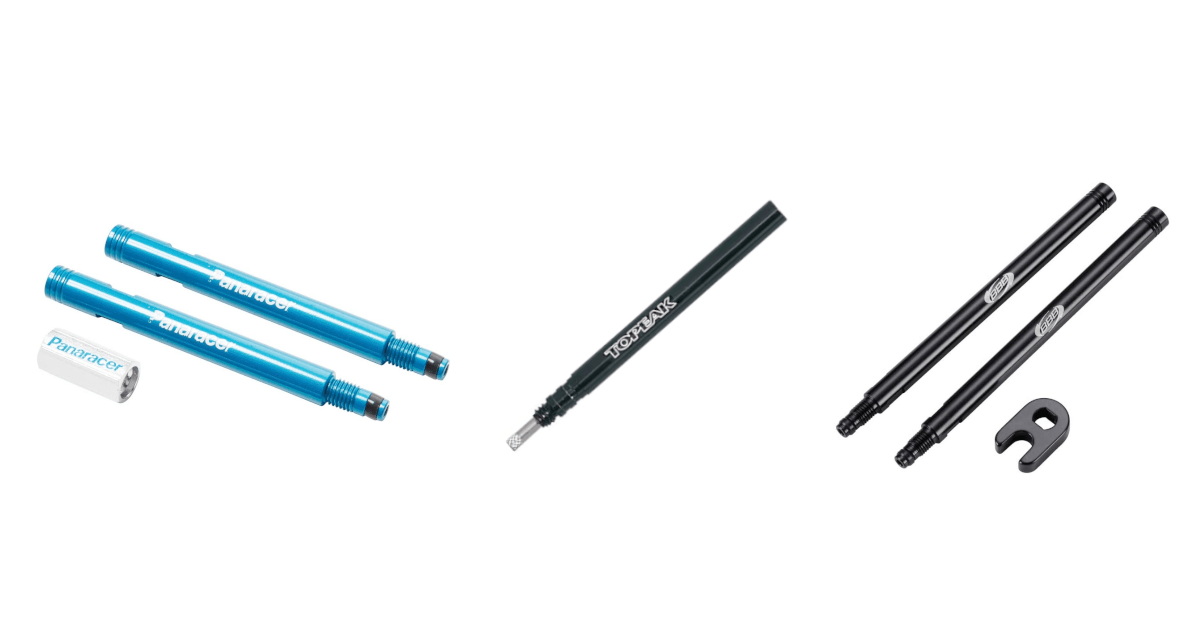What is a valve extender?
A valve extender is an accessory used to extend the length of the valve on a tube (or tire in the case of tubular tires).
On normal wheels, this is not necessary because the valve is long enough, but on deep-rimmed wheels, the valve must be extended due to the height of the rim to connect the valve to the inflator.
Valve extenders solve these problems.
Types of Valve Extenders
There are several types of valve extenders based on the method of attachment to the valve.
- joint type
- overlay type
- synchronous type
In the “Interlocking type”, the valve core is removed from the valve, the extender is inserted in place of the valve, and finally the valve core is attached. It is called “jointing” because it is simply extended.
The Kabusei-shiki type is used by covering the valve from the top, while the valve core remains attached to the valve. Since it is installed by loosening the screw at the end of the valve, if the extender and valve are incompatible, air will escape.
The synchro type (also called synchro extender) is also covered in the same way, but the extender itself has the same function as the valve core because it has a push pin at the tip of the synchro extender to release air.
Which method is best?
So which type of extender should you choose?
Here is a comparison of each type.
The first point is whether the valve core can be removed. The valve core must be able to be removed to use the joint type, but both the cover type and synchronized type can be used even if the valve core cannot be removed (even if the type can be removed).
Next is whether or not a special tool is required. Again, the joint type requires a special tool to remove the valve core, but the cover type and synchro type do not require a tool because they are simply inserted into the valve threads. For the joint type, the extender often comes with a tool, so this is not a problem, but it is necessary to carry a tool for repairing a puncture.
As for adjusting the air pressure, the joint type, which can use a valve core, and the synchronized type, which has a piston at the tip, can be easily adjusted. On the other hand, in the case of the cover type, the air pressure cannot be adjusted with the extender, so the valve core is used to adjust the air pressure. Keep in mind that it is difficult to adjust the valve core if it gets stuck in the rim.
Valve Extender Lengths
How much to extend the valve depends on the height of the rim and the length of the valve, so manufacturers sell valve extenders in a variety of lengths.
are the major ones.
How to Select a Valve Extender
Can the valve core be removed?
When selecting a valve extender, first check whether the valve core of the tube (or tire in the case of tubular tires) to be used can be removed. In many cases, this is not mentioned in the specifications of the tube or tire, but it may be mentioned in user reviews, so use that as a starting point, or contact the retailer for more information.
Decide how much length you need.
Next, check how much extension is needed. The length to be extended is
The length of the valve can be calculated approximately as follows: “(rim height + 30mm) - length of the valve.
The extra 30mm is the margin for connecting the valve to the inflator.
For example, if you are using a 40mm valve tube on a 50mm height semi-deep rim wheel
(50mm + 30mm) - 40mm = 40mm
so you would choose a valve extender that extends the valve by 40mm.
Decide on the installation method.
After all this has been decided, the last step is to decide on the installation method.
If you choose a cover type or synchronized type, you can remove the valve extender and operate it, or leave it installed and simply replace the extender by hand if you get a flat tire. However, if the valve and extender are incompatible, the valve may be pushed inside the extender, causing air to escape.
The advantage of the joint type is that it can be fixed firmly and has almost no compatibility problems, but its disadvantages are that you need to choose a tube whose valve core can be removed and you need to carry a tool. However, the relay type is the most reliable and can be used with confidence.
Which is better depends on the tube/tire and wheel you are using, so try to find the standard and method of operation that suits you best.
